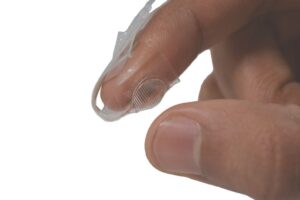Written by Paul Skelton, Connected magazine
Touch is crucial in how we perceive and interact with the world around us. Along with sight, hearing, smell and taste, touch helps us learn about our environment.
Technology capable of replicating our sense of touch – also known as haptic feedback – can greatly enhance human-computer and human-robot interfaces for applications such as medical rehabilitation and virtual reality.
How does the technology work?
Scientists at a Swiss research institute and university, Ecole polytechnique fédérale de Lausanne, have recently teamed up to develop a soft, flexible artificial skin made of silicone and electrodes.
A system of soft sensors and actuators enables the artificial skin to conform to the exact shape of a wearer’s wrist, for example, and provide haptic feedback in the form of pressure and vibration. Strain sensors continuously measure the skin’s deformation so that the haptic feedback can be adjusted in real-time to produce a sense of touch that’s highly realistic.
The study’s lead author, Harshal Sonar, says: “This is the first time we have developed an entirely soft artificial skin in which sensors and actuators are integrated.”
Amelia Kallman is a UK-based futurist, speaker, and author. Amelia specialises in the future of mobility, retail, audio, artificial intelligence and the internet of things.
“I got into haptics through my experience with virtual, augmented and mixed realities,” she says. “Through these new realities, we see and hear things that are virtual. Adding the sense of touch to these experiences actually tricks the brain that much more into believing it’s having a real experience.
However, Amelia says haptics is just the beginning of a completely immersive sensory experience that includes all the other senses.
For the next generation
Teslasuit used the CES 2020 exhibition to showcase its latest innovations including Teslasuit Glove. Teslasuit is a human-to-digital interface designed to simulate experience and accelerate mastery in the physical world. It integrates a combination of haptics, motion capture and biometry, opening up a wide range of opportunities for XR technologies in enterprise and public safety training, medicine and sport.
“The next generation is being raised to engage more senses at once,” Amelia says. “This means that we can start to combat the shorter attention spans that we have all acquired along the way.
“We are moving into an era in which we control devices through gestures, voice and touch. We don’t have to press buttons, turn dials or flip switches as we used to. But we’ve found that people are missing the satisfaction of confirmation or acknowledgment. Haptics provides that confirmation, telling your brain that you’ve actually done something.”

Under control
Current applications of haptic technology are so subtle that most people won’t notice their presence.
“On your smart phone, when you go to login and it doesn’t like your password it vibrates. That’s a form of haptics, albeit basic,” Amelia says. “But if you look at the Oculus Quest or even the HTC Vibe, they have haptics built into their controllers that are far more intuitive.”
Phillip LoPresti is the new chief executive of Tanvas, a company that pioneered ‘surface’ haptics.
“Haptics has been around for quite a while in various forms,” he says. “The one that most people will relate to is when you touch a button on your phone and your phone vibrates. That’s called vibrotactile haptics and it has been around for a while.
“It’s vibrating the entire device. That’s where we differentiate – our technology does not vibrate or move the screen in any way at all. We view it from the reverse angle; instead of the device being active and your finger passive, with Tanvas the device is passive.”
In June 2019, Mimo Monitors (distributed in Australia by avt) joined forces with Tanvas to launch the Mimo Vue with TanvasTouch. The 10.1″ touch screen combines the Mimo Vue display with TanvasTouch surface haptics, programmable textures and feelings on flat physical surfaces. The Mimo Vue with TanvasTouch pushes the boundaries of how touch can be used while creating an approachable, intuitive and novel experience.
“With more noise than ever competing for customers’ attention, engagement and mindshare, providing a rich touch experience is an effective way of cutting through the clutter.” says Mimo Monitors president and CEO David Anderson.
The future
Haptics is here now, but the full potential is yet to be tapped.
Amelia says training, particularly in the medical sector, is where haptics will shine. Fundamental Surgery is a software platform that takes advantage of readily available VR software combined with haptics to create a simulation system that can be used on any modern PC or laptop.
“I was once told by a doctor that medical students spend the least amount of time doing the most difficult procedures because they are the most dangerous,” she says.
“The only way to learn them effectively was to practice on people.
“Haptics changes that. Theoretically, we’ll be able to take the hundred best surgeons in the world and have them perform any routine surgery in a VR environment. Then we can take that data and correlate it, and from there we’ll able to identify the most efficient and cost-effective practices.
“Then we can train the next generation of surgeons on the best practices of the best doctors in the world.
“Ultimately though, the success of haptic technologies will come down to how effective it is and how many boundaries you push. There’s a lot of room for experimentation.”
Keep updated with the latest in developing and future technology news – Subscribe now to receive Integrate’s monthly newsletter Convergence.
